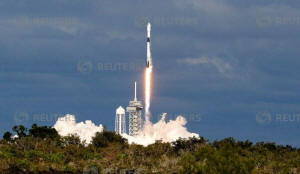|
The
mission, dubbed SSO-A, also marked the third voyage to space for
the same Falcon 9 rocket - another milestone for SpaceX's
cost-cutting reusable rocket technology.
The Falcon 9 blasted off from Vandenberg Air Force Base in
California at 10:34 a.m. local time (18:34 GMT) carrying
satellites from 34 different companies, government agencies and
universities.
SpaceX said the mission was "one of the most complex and
intricate endeavors" for Seattle-based startup Spaceflight, the
ride-share company that arranged passage for each satellite
maker.
The mission comes days after India fired a rocket carrying 31
satellites into space.
After the launch, the Falcon 9's first-stage booster returned to
earth as planned, landing on a ship off the coast of southern
California, according to a live video of the flight.
However, the Falcon 9's payload fairing - an enclosure that
protected the satellites during launch - missed a landing net on
the barge and ended up in the ocean.
"Falcon fairing halves missed the net, but touched down softly
in the water," Musk, SpaceX's chief executive officer, said on
Twitter. He said the boat was moving to pick them up.
"Plan is to dry them out & launch again. Nothing wrong with a
little swim," Musk, who is also the CEO of Tesla Inc <TSLA.O>,
said on Twitter.
(Reporting by Joey Roulette in Orlando, Florida, editing by Bill
Berkrot)
[© 2018 Thomson Reuters. All rights
reserved.] Copyright 2018 Reuters. All rights reserved. This material may not be published,
broadcast, rewritten or redistributed.
Thompson Reuters is solely responsible for this content.

|
|







